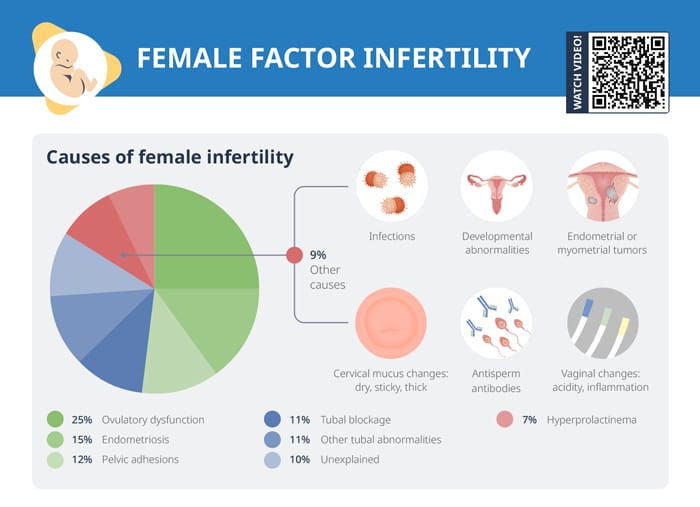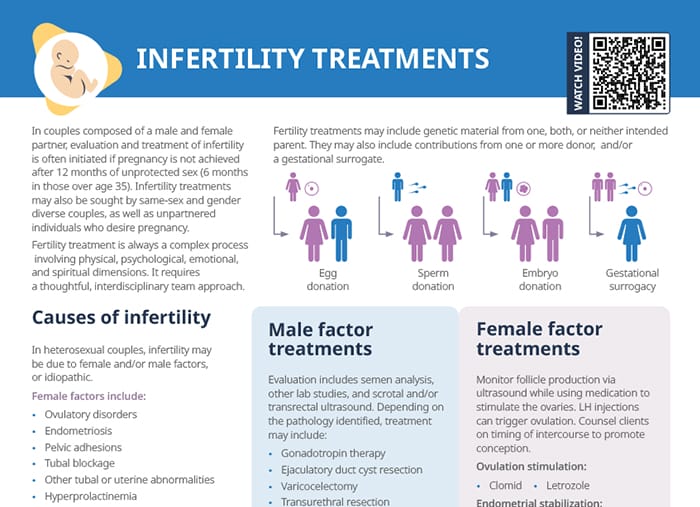What is infertility?
Infertility is defined as pregnancy not being achieved after 12 months of unprotected sex. In couples over 35, infertility treatments may be initiated after 6 months.
Related videos
How common is infertility?
Infertility statistics by the WHO suggest that roughly 1 in 6 people worldwide experience infertility, specifying the lifetime prevalence at 17.8% in high-income countries and 16.5% in low- and middle-income countries.
What causes infertility?
In heterosexual couples, infertility may be due to female and/or male factors, or idiopathic.
Causes of female infertility
- Ovulatory disorders
- Endometriosis
- Pelvic adhesions
- Tubal blockage
- Other tubal or uterine abnormalities
- Hyperprolactinemia
- Increased age
Causes of male infertility
- Endocrine imbalances
- Genetic factors
- Urogenital abnormalities
- Urogenital infections
- Malignancies
- Effects of medications
- Environmental toxins
How does endometriosis cause infertility?
Endometriosis is a condition where tissue similar to the lining inside the uterus (endometrium) grows outside the uterus. This can cause infertility through:
- Scar tissue formation
- Tubal blockage through adhesions
- Effects on ovarian function (reduced quality and quantity of eggs)
- Chronic inflammatory environment
Options for infertility treatments
Fertility treatment is always a complex process involving physical, psychological, emotional, and spiritual dimensions. It requires a thoughtful, interdisciplinary team approach.
Fertility treatments may be sought by couples unable to conceive after 6–12 months depending on the age, same-sex and gender diverse couples, as well as unpartnered individuals who desire pregnancy.
Fertility treatments may include genetic material from one, both, or neither intended parent. They may also include contributions from one or more donors, and/or a gestational surrogate via:
- Egg donation
- Sperm donation
- Embryo donation
- Gestational surrogacy
Male factor infertility treatments
Evaluation includes semen analysis, other lab studies, and scrotal and/or transrectal ultrasound. Depending on the pathology identified, treatment may include:
- Gonadotropin therapy
- Ejaculatory duct cyst resection
- Varicocelectomy
- Transurethral resection of the ejaculatory ducts
Female factor infertility treatments
Monitor follicle production via ultrasound while using medication to stimulate the ovaries. LH injections can trigger ovulation. Counsel clients on timing of intercourse to promote conception.
- Ovulation stimulation: Clomid, Letrozole
- Endometrial stabilization: Progesterone
Potential complications
- Multiple gestation: Treatments that stimulate the ovaries and procedures involving multiple embryo transfer may result in implantation of multiple ova.
- Ectopic pregnancy: Often related to structural abnormalities underlying initial infertility.
Assisted reproductive technologies
Assisted reproductive technologies may be used when male and female factor treatments are not successful, or when these treatments are not an option given client characteristics (e.g., in same sex couples).
Options include:
- Artificial insemination: procedure in which sperm is directly inserted into a female’s uterus, cervix, or fallopian tubes to facilitate fertilization
- In vitro fertilization: series of procedures where an egg is combined with sperm outside the body in a laboratory, and the resulting embryo is then implanted into the uterus
- Intracytoplasmic sperm injection: specialized form of IVF where a single sperm is injected directly into an egg
- Gamete intrafallopian transfer: eggs are extracted from the ovaries, mixed with sperm, and then immediately placed into the fallopian tubes
Common client questions and client education
Can birth control cause infertility?
Most forms of birth control, including oral contraceptives, IUDs, and implants, temporarily prevent pregnancy while in use, but normal fertility typically returns soon after stopping their use. Some clients may experience a brief delay in the return of regular menstrual cycles after discontinuing hormonal birth control, but this delay is usually temporary and does not result in long-term infertility.
Resources for patients struggling with infertility
- National Infertility Association (Resolve)
- American Society for Reproductive Medicine (ASRM)
- Online communities like babycenter.com and thebump.com
- Financing help like BabyQuest Foundation and FertilityIQ
- Recommend available fertility clinics, licensed therapists, local support groups, and other options suitable for the individual client (e.g., ideas like fertility tracking/support groups apps like Glow may be helpful)
How can infertility be tested?
Tests for males aim to check for if enough healthy sperm is produced, tests for females evaluate if healthy eggs are released by the ovaries.
Tests for males:
- Semen analysis
- Hormone and genetic testing
- Testicular biopsy
Tests for females:
- Ovulation testing and ovarian reserve testing
- Thyroid function tests
- Hysterosalpingography
- Hormone testing or imaging

